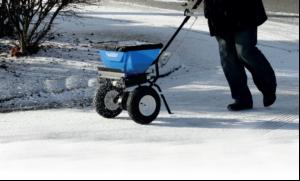Marcus Palmer offers pointers on how to prevent slip
and trip accidents this winter by keeping on top of bad
weather conditions
As well as welcoming fireplaces
and cosy woollies, winter also
reminds us of the less apMarcus Palmer offers pointers on how to prevent slip
and trip accidents this winter by keeping on top of bad
weather conditions
As well as welcoming fireplaces
and cosy woollies, winter also
reminds us of the less appealing
seasonal events including slipping and
sliding on paths. Slip and trip accidents
increase at this time of year due to less
daylight, falling leaves and the build up
of snow and ice on pathways. It is good
health and safety practice to not only be
aware of potential seasonal risks, but be
ready to tackle regularly used areas
promptly.
There are five key aspects which must be
considered when tackling winter 'slip and
trip' hazards: lighting; wet and decaying
leaves; rain water; ice, frost and snow; plus
gritting. Keep all these in mind and be
prepared. As well as keeping the public
safe, poor health and safety practices can
also impact the bottom line: business
interruption due to inaccessible loading
areas, closed access or unsafe areas can
lead to substantial loss of revenue. It keeps
everyone happy - including the financial
director - if you are well prepared for
winter weather. Let's consider the
application of salts, ice melts and the need
for snow management products:-
Rock salt
Firstly, when managing any public area,
the health and safety professional will
have carried out a risk assessment and put
a plan in place. Areas which put
pedestrians at risk need to be identified.
Whilst conditions are dry, think ahead:
should I put up a covered walkway or
should I consider insulating materials?
Even if you do these, you will still need an
application product such as salt to hand.
To keep areas clear of ice, a de-icer is
required with rock salt being the most
commonly used. Rock salt is generally
brown in colour, mined in the UK and
works by reducing the freezing point of
water on surfaces. Salts need to be applied
prior to onset of freezing as a saline
solution is required before the salt is
effective. When weather forecasts predict
below freezing temperatures, spreading
should commencing late afternoon - i.e.
before the frost settles. You should of
course also monitor temperatures yourself.
If you apply salt when it is raining heavily,
it will simply be washed away.
The spreading of rock salt can be
frustrating. The combination of the
properties of salt - generally inconsistent
particle size and potentially high moisture
content - and the type of spreader used
can make spreading difficult. Dry, free
flowing and consistent particle sized
material can be spread through a wide
variety of spreaders, however some are
specifically designed to handle rock salt.
Brown rock salt tends to leave a brown
residue which can be walked into
reception areas but there is a way round
this.
Processed white salt
An alternative is processed white salts.
These tend to be easier to spread due to
their purity providing the white
appearance, much like table salt, a low
moisture content and a more uniform
particle size. White processed salts can be
spread with a variety of spreaders. If you
need to use rock salt near front entrances
of areas which need to maintain a clean
appearance, this - alongside ice melts -
could be the solution you need.
Ice melts
Ice melts are designed for effective
performance at a greater range of
temperatures and are fine granular
materials that can be spread easily and
accurately. Ice melts are easy to handle in
both granular and liquid form providing a
much less (very low) corrosive option
ideal for corrosion sensitive areas and
where appearance matters. Accurate
spreading means these materials can be
very cost effective in use. Liquid ice melts
can sprayed through knapsack, handheld
or pedestrian sprayers specifically
designed for the purpose.
Ploughs & shovels
If snow has accumulated then best practice
is to remove it before applying any salt or
ice melt. For speed and efficiency, snow
equipment like pedestrian snow ploughs
and snow shovels are designed to make the
job easier, less strenuous and quicker.
To ensure your business is prepared,
our winter check list (left) provides a
guide to the products suitable to keep you
prepared for next winter.
Marcus Palmer is managing director of
snow and ice equipment company
DMMP


